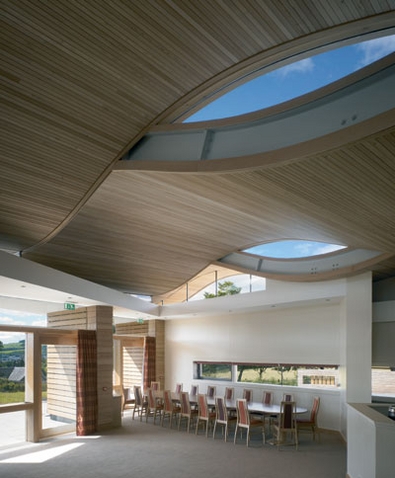Nick Moore of Timbertrends shines the spotlight on wood
01 — Timber in construction
In many countries, timber is the building material of choice.
Not only is it aesthetically pleasing, it is also versatile and cost effective. As solid wood or as laminated timber, it is used in all aspects of construction from beams and roofs, to doors, windows and floors, as well as for decorative features such as mouldings, cladding and surfaces. Other applications include formwork, hoardings, scaffolding.
There are few substitutes for timber windows, doors and floors that provide the same functionality and warmth. Windows that use treated timber require little maintenance and can have lifespans of more than 30 years.
Timber is quick to build with, and it meets and often exceeds the Building Regulations’ requirements for thermal insulation, sound transference and air-tightness. It also has excellent environmental credentials.
These benefits have encouraged the development a global timber industry.
02 — Market conditions
The construction industry is responsible for 70% of timber consumption in the UK and 50% consumption worldwide. In some countries, 90% of new houses use timber frames.
Consumption of timber is rising worldwide. The rapid expansion of China and other emerging economies, a resurgent demand for sawn timber in Japan and continuing demand from the USA, have led to a period of sustained price growth.
After allowing for inflation, the value of a cubic metre of wood had fallen for many years – but since the beginning of 2005, prices have started to rise.
To choose an extreme example, the price of Swedish redwood was 1,600 Krona a cubic metre in mid 2005 but this rose to 1,800 Krona earlier this year – an increase of more than 12%. Other timber products have risen, too.
The price increase stemmed from a shortage of raw materials and not enough production capacity to meet the rising demand.
Log shortages in traditional suppliers, such as Russia, have placed pressure on the sawn production industries in the Baltic States and neighbouring countries.
Sawn production has disappeared in some countries, such as Finland, where sawmillers were not making a profit.
These factors have led to a rapid erosion of the “surplus” of sawn softwood production over consumption between 2003 and 2005.

03 — Tender prices
It is uncertain whether the USA and the far eastern economies will continue to grow, and there has been a shift towards trade protectionism. These factors mean the rapid increase in demand and timber prices may slow down.
In 2006 there is likely to be a balance between consumption and production. As such, for the rest of this year and in 2007 we can expect to see a period of cooling in timber markets and a restored equilibrium between supply and demand.
However, it is doubtful that prices will reduce to a level where it is no longer economically viable for firms to continue trading.
The benefits of timber continue to outweigh its price, especially when energy costs and prices of other raw materials are taken into account. Therefore, the construction industry will have to factor higher prices for timber into building projects.
04 — Lead times
The complexity and diversity of the timber industry means it is hard to quote standard lead times. The supply chain for timber products is a web of innumerable interactions between suppliers and customers. Different customers with different requirements buying “standard” products, semi-finished manufactures, or special sizes, grades and species generate a multiplicity of supply arrangements.
Most timber comes from overseas. Traditionally timber importers would hold large stocks of timber to meet the needs of all kinds of customers. This arrangement still exists, but has been augmented by the growth of direct deliveries from overseas mills to timber user.
Examples of lead times include the traditional timber importer at the “wholesale” stage of the supply chain working to an order-to-delivery cycle of anything from a week to three months from the overseas saw mill. Another example is the directly supplied user, such as a timber-frame housebuilder, which may want a regular weekly delivery from a larger importer or terminal operator.
At the retail stage of supply, the jobbing builder who wants relatively small amounts of standard timber sizes and grades, or sheet materials, can walk into his local builders’ merchant, or timber merchant, and buy his requirements on a daily basis directly from stock. Similarly, the DIY enthusiast can go to their local DIY store and select from a wide range of timber-based products.
05 — Future developments
Timber products are being improved and developed continuously, creating new opportunities for their use in the the construction industry.
Recently, chemically modified timber has been improved, which means that products can be used where previously steel and concrete were considered.
In addition, there has been an increasing development of engineered wood products, for example, I-joists, which are widely used in flooring; laminated veneer lumber, which is used to support joists in flooring; and glulam beams, which are used for large structures, such as sports halls, schools, warehouses, roof systems, bridges and churches.
Modular floor systems are used by housebuilders in residential and commercial projects because they have a fast assembly time, are structurally sound and have an impeccable safety records.
The growing need for renewable energy and stricter policies aimed at reducing the impact of climate change are likely to facilitate further expansion of forestry. The UN estimates that the total forest area in Europe will increase 5% between 2000 and 2020. This is vital, since increasing numbers of applications for timber are being developed and demand in existing markets, such as construction, is continuing to increase.
























No comments yet